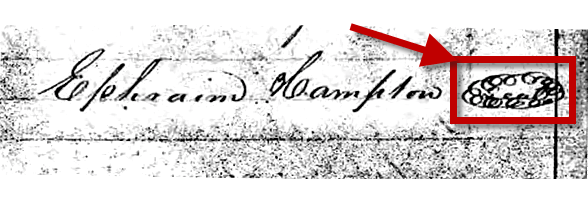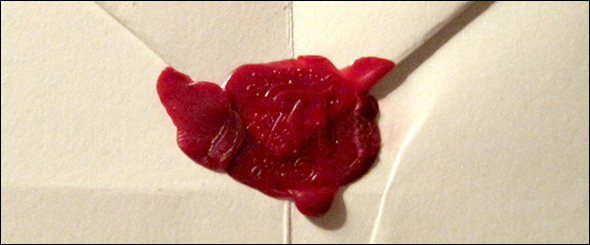That curly thing on documents
Reader Kate Trigger Duffert needed some help with a symbol that appeared on an ancestor’s will and, in searching for an answer, came across an older blog post about the marks our ancestors often used to sign documents.

“Found this blog in searching for that squiggly symbol there to the right,” she said, about the 2012 blog post “X (or W) marks the spot.”1 “It is on a document ‘signed’ by my ancestor directly to the right of his name. I thought it may be a mark, but I am seeing it elsewhere on documents online. What is this squiggly circle?”
Great question.
First off, it’s not a mark. By definition, that’s a substitute for a signature by a person who couldn’t write:
A character, usually in the form of a cross, made as a substitute for his signature by a person who cannot write, in executing a conveyance or other legal document. It is commonly made as follows: A third person writes the name of the marksman, leaving a blank space between the Christian name and surname; in this space the latter traces the mark, or crossed lines, and above the mark is written “his,” (or “her,”) and below it, “mark.”2
In Ephraim Hampton’s case, there’s no mark at all. Apparently he could sign his name, and even if this is a clerk’s copy of the will, it’s intended to show that he signed, rather than used a mark.
So what is it?
The clue to the answer comes right inside the squiggle itself. It’s the word seal that the squiggle is around.
Originally, a seal was “an impression upon wax, wafer, or some other tenacious substance capable of being impressed.”3

Over time, however, the wax seal fell into disuse, replaced by a “mark which is to supply the place of a seal, made with a pen or other instrument on a writing.”4 And rather than requiring a wax impression, the seal was simply “a particular sign, made to attest, in the most formal manner, the execution of an instrument.”5
Yeah, yeah, yeah. But what about the squiggle around the word?
It really does have a name, too. It’s a scroll: “A mark intended to supply the place of a seal, made with a pen or other instrument of writing.”6 In some states, according to Black, it may be called a scrawl.7
Oh, and by the way… the particular place where the scroll appears also has a name, in legal Latin. It’s the locus sigilli: “The place of the seal; the place occupied by the seal of written instruments. Usually abbreviated to ‘L. S.’”8
So while not every wiggle or squiggle on a legal document will have meaning, this particular squiggle does: it serves the function of the old wax seal, is called a scroll (or scrawl), and is placed at the locus sigilli in order to formally or officially verify or attest to the signing of the document.
Cite/link to this post: Judy G. Russell, “Wiggles and squiggles,” The Legal Genealogist (https://www.legalgenealogist.com/blog : posted 26 Aug 2019).
SOURCES
Image (wax seal): Wikimedia Commons, user Contrafool, CC-BY-SA-3.0.
- Judy G. Russell, “X (or W) marks the spot,” The Legal Genealogist, posted 5 Apr 2012 (https://www.legalgenealogist.com/blog : accessed 26 Aug 2019). ↩
- Henry Campbell Black, A Dictionary of Law (St. Paul, Minn. : West, 1891), 755, “Mark.” See also John Bouvier, A Law Dictionary Adapted to the Constitution and Laws of the United States, rev. 6th ed. (Philadelphia : Childs & Peterson, 1856), 2: 108, “Mark” (“a sign traced on paper or parchment, which stands in the place of a signature, usually made by persons who cannot write”). ↩
- Black, A Dictionary of Law, 1068, “seal.” See also Bouvier, A Law Dictionary…, 2: 502, “seal” (“wax, with an impression… is the common law definition of a seal”). ↩
- Bouvier, A Law Dictionary…, 2: 502, “seal.” ↩
- Black, A Dictionary of Law, 1068, “seal.” ↩
- Ibid., “scroll,” 1067. ↩
- Ibid., “scrawl.” ↩
- Ibid., “locus sigilli,” 731. ↩



How interesting and informative. Thank you.
When I lived and worked in South Carolina, I had a lawyer friend who often did work for illiterate elderly persons. When a signature was needed, he would hand them the pen and tell them to “touch the paper,” and they knew to make their mark. I heard that term neither before nor since, and wonder if it was simply the local vernacular, a generational vestige, or an actual legal term. Since then, I have become familiar with the term “touching such worldly estate,” frequently used in old wills. When I checked my copy of Black’s Law, 3rd edition, I found nothing about the word touch used in either context. So, I wonder, have you heard the term “touch the paper” as a way of saying, “make your mark,” and is there a legal meaning of the word “touch” when it was used in wills?
I’d have to say this is a local phrase, John. It’s certainly not something I’ve ever heard nor can I find it in any legal reference.
Thanks, Judy. I had not thought about the phrase, “touch the paper” in many years, but now it’s stuck in my mind. Since Black’s Law and you informed me that it’s not a legal term, I thought perhaps it was a term once in general use, but now rarely used. Here, Google was my friend.
https://www.merriam-webster.com/dictionary/touch
“Touch the paper” appears to meet definition #11: “to draw or delineate with light strokes,” or definition #10: “to leave a mark or impression on.”
And “touching such worldly estate” seems to fit definition 8a: “to relate to : CONCERN.”
My error was in presuming that these were legal rather than general terms, because I had encountered them only in legal settings. Live and learn.
Thank you for the explanation. I’d been thinking that this was to represent a seal (wax or stamp) that had been applied to the original. I.e., since what I was looking at was a hand-written copy of the original, the transcriber simply did the little squiggly thing with “seal” inside to represent the real seal on the original.
Just a note regarding the cross – it may confuse some people. A mark in place of a signature was an X (although some call this a cross) while the cross in the printed t looking symbol in a document was a symbol of death or burial.
Sometimes, people do not check out the signature — but sometimes, they do:
https://www.tickld.com/funny/1843519/man-makes-the-staff-at-walmart-lose-their-minds/
🙂
I worked in a law firm and a client asked if she was supposed to tape it sealed!
🙂